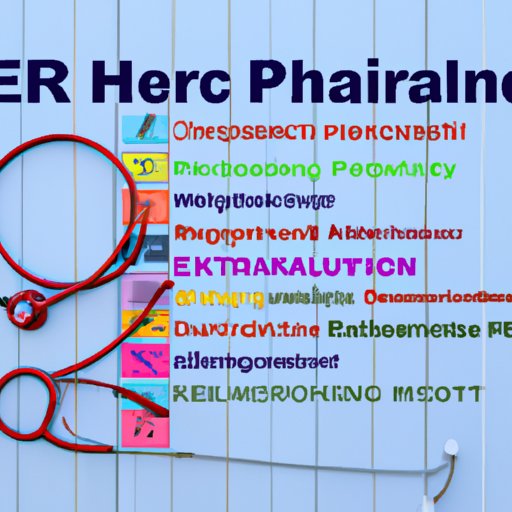Introduction
Certified Electronic Health Record (EHR) Technology is a digital system that allows health care professionals to store and share patient information securely and efficiently. It is designed to improve the accuracy, quality and safety of patient care by streamlining clinical processes, improving communication between providers and eliminating unnecessary paper-based processes.
The use of certified EHR technology has been gaining momentum in recent years, as it offers increased efficiency and improved patient care. However, there are still some challenges associated with its implementation that need to be addressed. In this article, we will take a closer look at the benefits and challenges of certified EHR technology, as well as explore how it works and what the future may hold.

Examining the Benefits of Certified EHR Technology
Certified EHR technology provides numerous benefits to healthcare providers, including improved patient care, increased efficiency and improved accuracy of records.
Improved Patient Care
Certified EHR technology can help improve patient care by providing physicians with real-time access to patient information, such as medical history, lab results and medications. With this information readily available, physicians are able to make more informed decisions when diagnosing and treating patients. According to a study conducted by the Journal of Medical Internet Research, “the use of EHRs was associated with improved quality of care outcomes, including lower rates of mortality and hospital readmission.”
Increased Efficiency
Certified EHR technology also increases efficiency by streamlining administrative processes. For example, billing and scheduling tasks can be completed faster and with fewer errors. Additionally, electronic prescribing eliminates the need for handwritten prescriptions, which can reduce medication errors.
Improved Accuracy of Records
Lastly, certified EHR technology improves the accuracy of patient records. By eliminating manual data entry, there is less chance for errors. Additionally, EHRs are designed to incorporate evidence-based guidelines into clinical decision-making, which helps to ensure that patients receive the most appropriate care.

Exploring the Challenges of Certified EHR Technology
While certified EHR technology offers many benefits, there are also some challenges associated with its implementation. These include the cost of implementation, training staff to use the technology, and interoperability issues.
Cost of Implementation
One of the biggest challenges associated with certified EHR technology is the cost of implementation. In order to implement a fully functional EHR system, healthcare organizations must invest in hardware, software, and personnel training. Additionally, they must update their systems regularly in order to stay compliant with industry standards. According to a study published in the International Journal of Medical Informatics, “the total costs of implementing an EHR system range from $15,000 to $50,000 per physician.”
Training Staff to Use the Technology
Another challenge associated with certified EHR technology is training staff to use the technology. Physicians and other healthcare professionals must be trained on how to use the technology and understand the associated workflow processes. Additionally, they must be comfortable with the technology in order to use it effectively.
Interoperability Issues
Finally, certified EHR technology can also face interoperability issues. Interoperability refers to the ability of different systems to communicate and exchange data. If two different systems cannot communicate with each other, then the data stored in each system cannot be shared. This can lead to delays in care and an increase in errors.

A Look at How Certified EHR Technology Works
In order for certified EHR technology to work properly, there are certain technical requirements that must be met. These include security protocols, data exchange standards, and other technical specifications.
Technical Requirements
First and foremost, all EHR systems must meet certain technical requirements, such as data storage capacity, user authentication, and encryption methods. Additionally, EHR systems must adhere to established standards, such as the Health Insurance Portability and Accountability Act (HIPAA) and the Office of the National Coordinator for Health Information Technology’s (ONC) Health Information Technology Standards Panel (HITSP).
Security Protocols
In addition to meeting technical requirements, EHR systems must also adhere to certain security protocols. These protocols help ensure that patient data is kept secure and confidential. Common security protocols include two-factor authentication, role-based access control, and audit logs.
Data Exchange Standards
Lastly, EHR systems must adhere to certain data exchange standards. These standards help ensure that data can be securely exchanged between different systems. Common data exchange standards include HL7 messaging and FHIR.
The Future of Certified EHR Technology
As certified EHR technology continues to evolve, there are a few key trends that could shape its future. These include the potential use of artificial intelligence, the expansion of connected health systems, and an increasing focus on patient privacy.
Potential Use of Artificial Intelligence
One trend that could shape the future of certified EHR technology is the potential use of artificial intelligence (AI). AI can be used to automate routine tasks and provide personalized care recommendations. Additionally, AI can help identify patterns and generate insights that can improve clinical decision-making.
Expansion of Connected Health Systems
Another trend that could shape the future of certified EHR technology is the expansion of connected health systems. Connected health systems allow healthcare providers to access and share patient information across multiple organizations. This could lead to improved care coordination and better patient outcomes.
Increasing Focus on Patient Privacy
Finally, an increasing focus on patient privacy could also shape the future of certified EHR technology. As more patient data is collected and shared electronically, it is essential that healthcare organizations have robust security protocols in place to protect patient data.
Conclusion
Certified EHR technology is an important tool for improving patient care and increasing efficiency. While there are some challenges associated with its implementation, the benefits far outweigh the costs. Additionally, the future of certified EHR technology looks promising, with the potential use of artificial intelligence, the expansion of connected health systems, and an increasing focus on patient privacy.
(Note: Is this article not meeting your expectations? Do you have knowledge or insights to share? Unlock new opportunities and expand your reach by joining our authors team. Click Registration to join us and share your expertise with our readers.)
